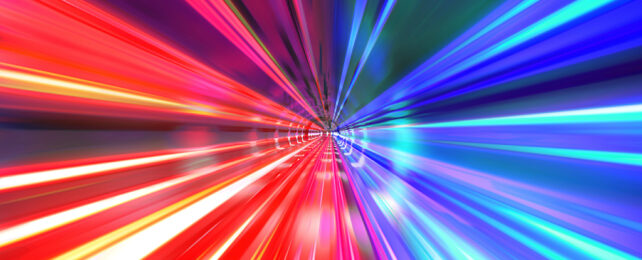Scientists experimenting with some of the most fundamental laws of physics have found more evidence of what they're calling photonic time crystals (PTCs): materials in which the speed at which light moves (the refractive index) oscillates very quickly.
We already know much more about photonic crystals, where a repeating pattern in a material creates a shifting in the refractive index over an area of space; you can see this in the shimmering of insect wings or precious minerals. With PTCs, the element of changing over time is introduced too.
Here, researchers trained lasers on two materials known as transparent conducting oxides, which allow light to pass through while also conducting electricity. They used the lasers to rapidly change the refractive index for periods less than 10 femtoseconds (that's 10 quadrillionths of a second).

Researchers observed significant shifts in the light frequency and in the light relaxation time (the time needed for the refraction index to return to normal), depending on the thickness of the material and the speed with which the refractive index was altered.
"Electrons excited to high energy in crystals generally need over ten times as long to relax back to their ground states, and many researchers thought that the ultra-fast relaxation we observe here would be impossible," says physicist Mordechai Segev from the Technion-Israel Institute of Technology.
"We don't yet understand exactly how it happens."
If your head isn't already aching from the high-level physics here, there's more than one type of photonic time crystal. The research here is separate from photonic time crystals that can manipulate light for various advanced purposes.
So far, these types of PTCs have only been observed using radio waves, which have much lower frequencies than light waves – the faster the waves pass, the higher the frequency. Keeping PTCs stable depends on the refractive index rising and falling in the space of a single electromagnetic wave cycle.
That's much more challenging in the super-speedy realm of light waves, which is part of what makes these experiments so interesting. The researchers weren't quite able to observe PTCs in the visible light spectrum, but they got close.
As Segev says, it's not clear precisely why this is happening or how it might eventually be used, but we're talking about breaking new ground in physics – a "new chapter in the science of light", according to Vladimir Shalaev, an electrical engineer at Purdue University in the US.
"Our findings… pave the way for observing photonic time crystals at optical frequencies, and many other phenomena involving time boundaries," write the researchers in their published paper.
The research has been published in Nanophotonics.
